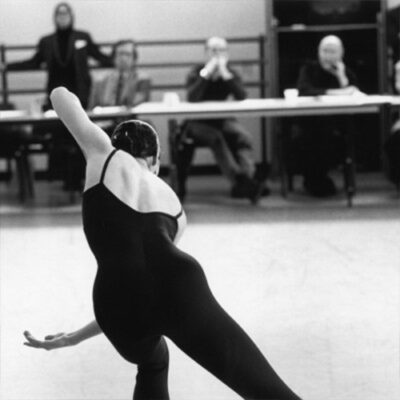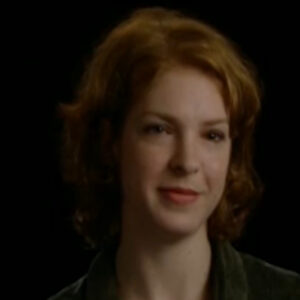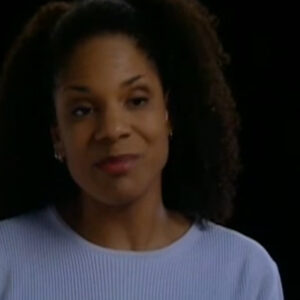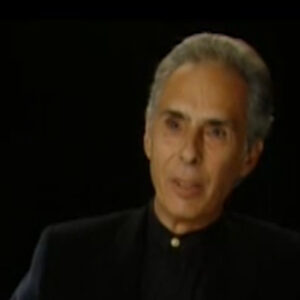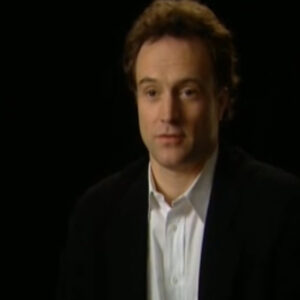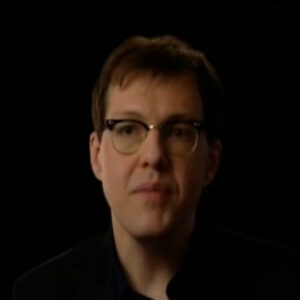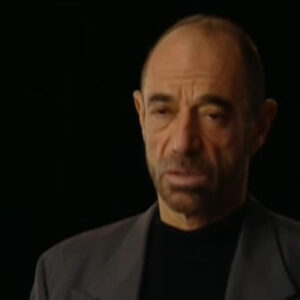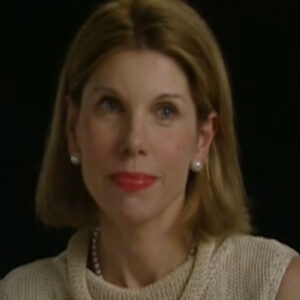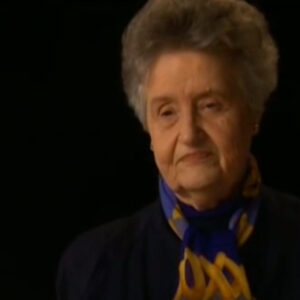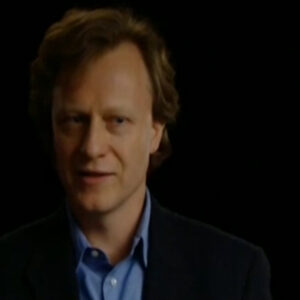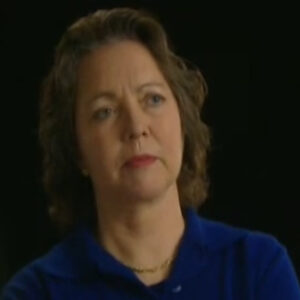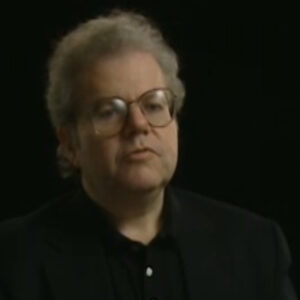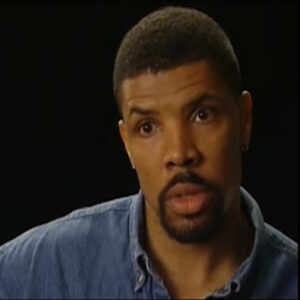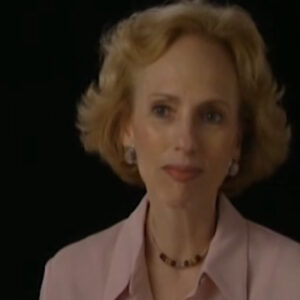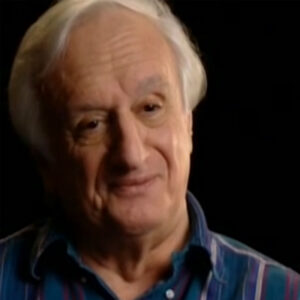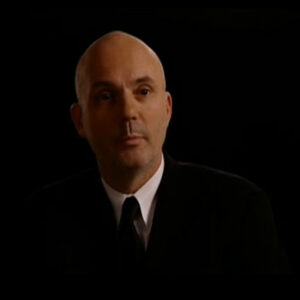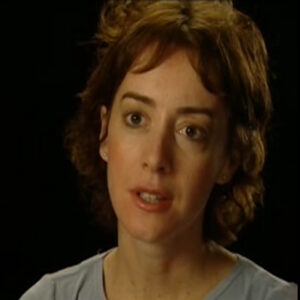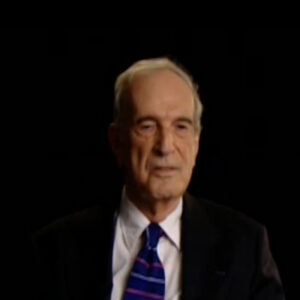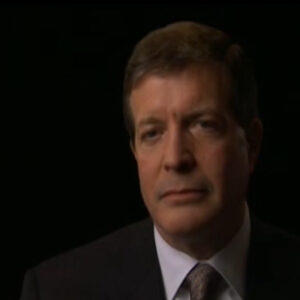Speaker Juilliard. When you were there. How you ended up getting there?
Speaker What you knew about who?
Speaker I was 17. Living in Hawaii. And Anthony Tutor had come through Hawaii on his way to study at a dojo in Tokyo. My ballet teacher had been a protege of his a Juilliard. And he talked to tutor about me and said, you know, she doesn’t have a very good dancer spot. It’s a long torso, short legs. But when she moves, it’s interesting. So Tutor said, well, if she has something, you’re just gonna have to center for the audition and see if she can cut it. So within a matter of two weeks, I had to change my focus from enrolling as a freshman at the university. What you got on a plane, flew 3000 miles, landed in New York City, which was a huge cultural shock, and walked up to what was then the front of Juilliard on a side street, this enormous structure. And it was their first year at Lincoln Center. And so the entrance was windowless, just this massive structure. You walk into a very dimly lit reception area with a guard desk and the guard, you know, walked up, auditioned and waited for two weeks to see if I was going to get in.
Speaker And I did. But out of this incredible nervousness and fear and uncertainty about myself and my future, if there was going to be a future, I was accepted into what I termed the Juilliard tribe. And it has continued to continue to be of a tribe in the sense that the generations and the levels of mentorship helped to me make this quantum leap from a very naive, young, aspiring dancer into womanhood and the kind of of understanding of what the craft, the potential craft and what this art form could offer me. So, Julia, it has always maintained a very central force in my life, and it continues to.
Speaker Now, as as artistic director of American Repertory Dance Company, three of my founding artists were also Julia People. I am guest editor for an issue of this journal called Choreography and Dance. And the senior editor is Merial Topaze, who took over after Martha Graham retired. And two of my authors. The subject is on the profile of the healthy dancer from both physical as well as psychological perspectives. And I’m using two former classmates to offer the articles. My company is going to be premiering a program called Generation Next that looks at where the legacy, the developmental arc of the legacy of modern dance has come. And LA Lubavitch, of course, is Juilliard alarm as as Susan Marshall. So it’s just there has been a continuing network of the tribe, you know, which I love.
Speaker And what was it like when you first got there growing up? What was the reveal? What kind of classes were they looking at you? How were they figuring out you? And how are you now?
Speaker When you take the audition and get in, there’s a placement class that you have to take. What was so extraordinary for me about Juilliard is I had gone there really to study with Tutor because I loved ballet and ballet was my life. And that was really what I felt was my focus.
Speaker And tutor definitely took me under his wing. But the whole modern segment was something very foreign. And what was so extraordinary about what Martha Hill conceived is that this was an institution that was going to train the full dancer. So you were required to do both ballet and modern for the first couple of years before you declared a major trying to place myself inside of this. The modern realm was so foreign and in it, it made me very nervous and and very insecure because it was a way of moving my body that I felt not very comfortable with.
Speaker I didn’t like rolling around on the floor. I didn’t understand so much of the movement vocabulary and I didn’t understand the intricacies of what that that art form required.
Speaker But the Juilliard regimen continued to employ different facets of the modern within the week.
Speaker We had alternate days so that we had the Graham technique and Humphrey, Lee and Hosie was still teaching at that point. And we had a wonderful faculty of of modern people that spanned pretty much the golden age of the Martha Graham Company as well. We had composition.
Speaker We had literature and materials of music and anatomy. And it was areas of exploration that I had never had. So on the one level, there was the physical training that I was trying to to keep step with. But on the other hand, there was a whole intellectual and emotional development that at times really took me off my pins and totally took me off my guard. But in retrospect, those moments were what were so extraordinary. And even though at the time harrowing and uncomfortable elevated me into areas that provided the strength and the knowledge to work with someone like Martha Graham later. And one of the moments I remember in ballet class, we just started to do exercises and tutor was roaming the class and he passed by me. And I’m concentrating him very thinking about where my placement is and all these things. And he stopped just ahead of me so that I could see the back of his head and felt the eyes. I felt you were staring at me. And he said, So when was the last time you went to Central Park and just watched people?
Speaker And then he went on. And that’s what it took me.
Speaker I mean, it still resonates with me because it’s moments like that that these these incredible dance masters. Asked us to go beyond what it is that we know.
Speaker And I still do that even as a technique with the classes that I teach at UC Irvine. I still use that because that’s, I think, one of the things that made Juilliard a dance division so extraordinary. It’s not just the physical training, but it’s the intellectual development. It’s the learning to take the dare and delve into areas emotionally that we’re not particularly comfortable or unknown at that point and find out what came up out of that. You know, this is the dancers just have this instrument. And this is what we communicate with. We don’t have the benefit of words or verbal. So this has to articulate and communicate so succinctly. The steps, the movements are empty until we go into it and immerse ourselves into it and then bring it to life. And it’s those kinds of subtleties that I was struggling to understand, struggling and trying not to be so afraid to experience it. It dominated my first chair.
Speaker I just want to tell you one second, because I want to ask you this, do we need in order to go wider because we have to cover the size of the chair right now. Besides, I can’t go that way. Okay. Good luck. That’s why you’re great. That’s perfect. OK, I just want to know if you can see them if you want to move the Blackcomb. OK. OK.
Speaker Because because it remains in a pure black.
Speaker I didn’t know how far back he taped the channel before, because I know that you have really kind of have a sense of the juror, the original seed of what became or maybe you don’t.
Speaker But I guess I thought I think that you sound like you do. I mean, what part of the Juilliard program come together? I mean, what was Martin Hill’s? Vision, as you interpret it. And when I mean, how did Juilliard find more of the hill? Who was she? This is lexicon of dance history. Hillyard says dance division. Let’s go get on the Hill. I mean, you know how that.
Speaker No, not specifically, except that Martha Hill in the 30s dance with Martha Graham Company. But I think her strength was not particularly as a performer. But Martha Hill was one of these very visionary people who understood networking before the term was coined and putting together and bringing about collaboration’s and going past just the narrowness of each particular style of dance. When she started the dance department in the early five or dance division of the early 50s, it was it was revolutionary bringing under one roof the ballet and modern because traditionally, if you wanted to get into a ballet company, you would go study in a ballet school. And certainly within modern, the age was not as crucial a factor as in the ballet. So dancers could, in fact, go to an academic institution and still have a professional career afterwards. Her her particular approach to dance then was more. Encompassing. And again, you know, I go back to the fullness and the various aspects of a dancer, which I think is continuing. You know, from what I’ve seen of of Ben Harkavy, whose tenure at Juilliard.
Speaker Without without it being able to develop the different aspects of the dance or having inroads into music with the literature and materials of music without having inroads into anatomy and the workings of the body to actually a long gait, our dance careers, those kinds of elements were not thought of within a traditional dance department. Oh, when and notation. The fact that they included love notation is part of the curriculum. You know, in addition to the regular composition and repertory classes and tutor, of course, taught his ballet ranchman class, which was more like a therapy session, I think. But what she conceived of as a kind of syllabus of study had not really been offered by any other institution. And so, so much of that is taken for granted now. But then it was quite inventive and quite daring. She certainly had her critics in. A lot of people said, oh, people go into Tueller. There’s no way that they’re going to get into a professional dance company, a ballet company. But that hasn’t necessarily been the case. So in that sense, yes, I think she was the right person at the right time in the right institution to add a dimensionality to what the Juilliard School was at that point. And it took a while, obviously, because, you know, the name was so synonymous with the Juilliard School of Music. The move into Lincoln Center, of course, was a landmark because, again, the inclusion of theater is a component, although we as students were not able to take advantage of theater, just having that element there and being able to interact with the actors changed, you know, the dynamic just as a student body.
Speaker Talk a little bit about some of these. I mean, if you really if you look back at the early faculty of Juilliard we’re talking about.
Speaker We’re talking about the king and queen, certainly modern. Yes. But what about Grandma with Grandma? I haven’t really talked to anybody yet. Was actually being taught by grandma. You later, grandma. Somebody. What was. Let’s start with grandma. What was Graves history at Juilliard?
Speaker Well, the initial faculty and I might be forgetting some names, but obviously it was Martha Dorce Humphrey.
Speaker Supposedly Mowen. And I believe Agnes de Mille was also involved. Tutor was obviously teaching. And I think Alfredo Corvina might have been there. I don’t know when Dr. Shirai guard came in to teach the anatomy and anatomy lab.
Speaker But even amongst that, that’s quite a distinguished faculty and really represents the pioneers of certainly the modern dance art form. And tutor was in his heyday. Choreographically, his works. And, you know, sometimes he’s referred to as the father of psychological ballet. Then Agnes’s inclusion and how she revelant revolutionized the American musical theater. All of these people were so progressive and so unafraid to chart new territory.
Speaker Martha Hill, again, because of her talent to network, to envision something that had not been done before and bring it to fruition. It all came together.
Speaker Now, when I was there in 69, Hosie was still actively teaching on a Sokolow was teaching or doing repertory in and out and from the Graham sector, Bertram Ross and Mary Hinkson, Ethel Winter, Helen McGehee, Kazuko Hirabayashi. There were several members from Hoess company who were also coming in to do teaching when Housei was off on tour choreographing something. Jennifer Mueller. Danny Lewis. The list was extraordinary for composition. The first year I had Lucas Hoving, who was one of the original members of Hoess company, and Muriel Topaze for a dance notation, who eventually was director of the Dance Mentation Bureau and then took over Martha’s posters dance division chair. It was an extraordinary time and I told Madeleine Nichols’ of the New York Performing Arts Library once, you know, I never once set foot in New York performing arts library because I didn’t feel I had to.
Speaker Any question I had about dance history, there were all there, but I was living it. And it’s true. It was just an extraordinary time.
Speaker And it also it was a time of great transition because, you know, just within the last five to seven years before I got to New York, of course, the Judson Church had emerged and there were rumblings again of something that was new. That’s something that hadn’t been done and rebelling against tradition. And Martha embraced all of that, even though they were not particularly part of the the curriculum at the Juilliard School. She encouraged us to go out, see as much as we could. And, you know, she would get these these notices so that for 250, we could do standing room, you know, to to go in and see and become more perceptive and understand the the aesthetics, the values the dance had to bring. It was exciting.
Speaker Talk to me a little bit about these these various techniques. I mean, Peter Viles is telling me that in the early 60s when she was there, you actually applied to the school and were accepted by either the grand people or the Lavone people.
Speaker And I know that’s that’s changed. But talk to me. I mean, what is the Graham technique? What is what is the thought of? I mean, now still, it’s a benchmark of your of your time there.
Speaker Is it you know, you are learning the Graham technique. What is it?
Speaker Well, both Martha and Dawes and Charles Wideman came out of the whole dentition school. And at that point, Miss Ruth was heavily influenced by Eastern tradition.
Speaker You know what? I’m going to start again on the level that if we don’t see Martha Graham, we’re going to go to hell.
Speaker Got it. OK.
Speaker We’ve talked about working with Martha Graham, Doris Humphrey and Charles Wiseman came out of the dentition school that was based here in Los Angeles school and company.
Speaker Martha was very entranced by the kinds of inspiration that Miss Ruth had gleaned from the Eastern traditions and philosophies.
Speaker The whole idea, you know, in in Asian dancers, a lot of opposition, opposition of the body were one part of the body is going in one direction. The other is folding. And there’s a kind of complexity yet containment. And so, yes, the sense of opposition is part of what Martha devise is her technique. But it is really based on breath, which she said was the very first and the very last thing that we do. So her signature contraction and release was a dramatization of that. And she came from a choreographic or she started with the choreographic approach that if you take a character at the moment in the fork of the road where they must choose one or the other. And there is no other choice. You are starting at a very exciting point. And if you track the different ballets, though, whatever, 200 that she choreographed over a very long span, those pieces that are in fact driven by a particular character, start out with that premise. If you start out at that point, some interesting things are going to go on. And she used the contraction and the opposition and the spiral away as ways of evoking what it was that the character was going through those emotional threads.
Speaker And she also had a phenomenal ability to choose particular composers.
Speaker When you chart her repertory, there’s an incredible richness of some of the great composers of the 20th century.
Speaker And she was part of that Juilliard group. So she had interchange with so many people who were, in fact, teaching at the Juilliard School. And she had a very discerning eye. So being able to bring in a sample, Noguchi, who was not known at that point, and to pair with lighting people like Jean Rosenthal to create theater.
Speaker And it’s that element of theater that had not been seen in that context before, that some people felt very threatened and didn’t want to go there, did not want to see didn’t want to be bothered by or just said yes. She used to say that she wanted people to either love or hate her choreography, but never, ever just feel mediocre about it.
Speaker What was she like? I mean, how did she conduct herself to see her family?
Speaker Well, she wasn’t teaching anymore because she went through a period in the late 60s of not very good health. The first year that I was there, 69, 70, she gave permission for the Juilliard Ensemble to perform diversion of angels with the caveat that we had to go over to the studio and do the piece for her first before the performance. So we had been coached by that many of the people who had originated the piece in 1948. We trekked over to the grand studio and a 60 third sat down and were treated to. Just extraordinary enlightenment by this woman whose breadth of reading and whose photographic memory was extraordinary.
Speaker So what she touched upon and the elements that went into shaping this dance called diversion of Angels, came to light in a totally different way.
Speaker About love. The whole theme was about love and the kinds of love that is possible. It’s interesting to note she did not cast herself in this dance, although she was certainly able to move in the nineteen forties. But we performed the dance for her and of course she went off on us. And she said made comment that there was not anyone in this particular cast of diversion of angels that she would ever consider for her company. Well, the great irony is that four of us from that particular cast then went on to join her company this in the 70s. But she she had a very demanding personality of herself, but also of her dancers. And she wasn’t ready to settle for anything but the best, certainly within the company. She would keep most of us on that moment of in balance, not knowing what was going to happen with regard to casting, with regard to costuming, or if we were, in fact going to be with in the new piece. And I think that she did it because. When you’re trying to exist on that tightrope of uncertainty, you’re not able to use your habits than the natural defenses, the natural elements that support you as an artist. And it’s only through that moment of complete vulnerability.
Speaker Are you able to go to that next level and see what’s there?
Speaker She’s she is such a presence. I mean, I’ve seen the dancers world. There’s actually a guy who did a small film on Channel 13 called Richard.
Speaker Oh, Richard Move as my guest host a year ago with my dance company. Richard. Yes.
Speaker Oh, yeah. Yeah. Oh, yeah.
Speaker I mean, how was what was her role at Juilliard? What role was she ever playing? I mean, how did how was she perceived by the students?
Speaker How is she getting ourselves into the.
Speaker Well, in the context of the sea, as I say, I wasn’t there through the 50s when she was an active member of the faculty. And so by the time I was there in 69, her health was declining. And the only contact, direct contact that we had at that point was when we went over to the studio and had that particular extraordinary afternoon with her.
Speaker Can you give me a glass of water that you have? No legacy. The Juliar legacy. Yes. I mean, the profound work that was going on. 50S and 60s, Juilliard is hard to match because those things I’m wondering just I mean, this is something that is going to come later, but I’m thinking about it now. Go back. But, you know, the people that were at Juilliard, whether it’s Taylor is a student. Yes.
Speaker We’re talking about a kind of a benchmark of modern jazz. That hasn’t changed. It’s not like people came in in the 70s and 80s and sort of modernity kicked in. You’re still learning the Graham technique.
Speaker Well, you know, that’s interesting that you should address that, because I think that that’s been some of the criticism of the institution.
Speaker Now, within this this time is that Juilliard has steadfastly adhered to a training that is predominantly what I consider classic modern dance techniques. And I can’t speak to how they’re approaching composition now, but.
Speaker Modern dance is an art form has really been characterized. It was birthed as a acts of rebellion against tradition, and that basic tenant continues to characterise modern dance as we move forward with each generation somehow making a new statement and finding a new way that continues to spawn itself until somebody else steps forward and makes it the new next statement. Juilliard. To its credit, understands that without knowledge with of the history, how can you move forward in an informed manner to really understand the craft?
Speaker And I believe in that.
Speaker It’s there are so many other dance programs and institutions to look at for young dancers today. But Juilliard continues to create highly trained, intelligent dancers with the kind of solid background that enables them to do almost anything. I saw the senior concert a year ago when I was back in New York, and it was so exciting to see. Yes, the dancers are much more facile and Ben Harkavy has moved forward with different kinds of techniques and faculty to keep stride with the times. But there’s definitely still the thread, the connection to traditional kinds of techniques to shape the foundation for the young dancer. And that’s why I think Juilliard continues to place well with professional companies.
Speaker He sort of says Harkabi flies, that, you know, Juilliard is a bridge to this day and that, you know, they will train to dance or God to to dance as well in the first hour. As they do that, there’s a kind of day you can speak to that a little bit. The necessity of the of the classwork, of the rehearsal work, of the rigor of the program as to how that is. People always wonder, I mean, do you really need to go to a ballet class every day or do you really need to work 18 hours a day?
Speaker Well, the stamina, the perseverance, understanding, those elements that are so important, regardless of what performing art we’re talking about, that’s definitely a part of the rigors of the training. Initially going into the school, I was totally unprepared. I was physically exhausted. I think my first class started at eight fifteen in the morning technique class. And every day you had both ballet modern, you alternated between composition and repertory. I also had point class literature and materials of music. And because I wanted so much to immerse myself in everything tutor. I also took a class from Betty Sawyer called Lyricism and Musicality.
Speaker And this was an incredible class that took one, two to three combinations from tutors class. And Betty Sawyer, who was his accompanist, would then ask us to take the same movement, combat composition, but match it with totally different musical accompaniment. And that’s forced us to listen to shape to phrase, to understand nuance and texture and a whole different way. So on top of all of this input coming in, then after hours or on breaks, we would work with each other on student choreography for performances or repertory, for the dance ensemble performances. That would generally happen in twice a year. The big dance performances. So they were long days, incredibly long days.
Speaker And it does it builds your stamina and it it builds a certain sense of heart.
Speaker You have to have you have to dig down deep to find the heart to come back. Sometimes when you’re so tired or you’re so frustrated. And that’s part of the jewel. I think it’s part of any experience. But certainly within Julia, the standards are there. So you can’t let anything go. You have to keep all the balls in the air.
Speaker What is known law is legacy.
Speaker What is Ho say was one of the early teachers, modern faculty that I gloved onto. Immediately there was such strength and such a nobility about this man. And unlike some of the other modern dance faculty who took a more hard nosed approach that, you know, you’re going to I’m going to give it to you all now because this is what you’re going to have to go through. He was much more gentle in his approach. He didn’t feel the propensity to attack us or to force us into great emotional growth or whatever. The first year we did his beautiful dance called There is a Time, and this was before whosay became ill.
Speaker And so he was still very vital and very energetic. He took the time to explain things and he demonstrated quite fully the various sections as he was putting this piece together. And because he was still so powerful in his own body, I could see so clearly what it was that could enliven movement and what it is that makes dance so irresistible. Because in the simplest movement, all of a sudden you saw everything. And it was really extraordinary. So many of us felt that he was a father figure. And I think that he was, you know, a very stable, fairly free of neurosis. You know, I mean, in terms of his interaction with the students. And that was beneficial. And Martha Hill understood that.
Speaker She understood that she could not just have a faculty that brutally took us, you know, to places where we had not been before.
Speaker It was a haven working with him. And I’m so glad that I encountered him at that period because I know that when he became ill and wasn’t able to teach as much and wasn’t able to be there as various other pieces of his were remounted, that the kids didn’t have the same kind of knowledge of his pieces, their original stories were there conveyed to us.
Speaker And what is it about the different philosophy? What is the most?
Speaker Well, you know, Housei danced with The Doors, Humphris Company and Doors. Humphrey was exploring movement in a very different philosophical approach than Martha. She was looking at at movement that existed in an arc between balance and unbalance. Hence her theory of fall and recovery. And so that obviously became Hoess technical heritage. And when Housei formed his comfrey company, Dorce Humphrey came in as artistic adviser and worked very closely. Still, there was a very close mentorship protegé relationship between the two of them. So, you know, Hosain lineage. Definitely. It comes from the Humphrey what Dorce devised as movement theory. And so unlike the percussive ness and the dynamic thrust of the gram, there was certainly still dynamics. But it was in. It was the whole thing of the breath. And what happens in the the the arc. The arc.
Speaker I have had a lot of people sort of talk about him as being.
Speaker Sort of looking over the crowd that he had, there was a kind of a grandeur to him and think about it somewhere. Moanin Tutor had a bit of a riff to herself, if they would like Julia.
Speaker It was a palace of kings and queens.
Speaker So I think that’s, you know, a lot of that passing, you know.
Speaker But palace intrigue. You know, there was a certain carriage as a physicality that was just Hosie. And he had this extraordinary head like Tudor and neck. And this massive chest. So there was a carriage that was just part of him. I don’t know that he was consciously trying to be kingly, but he just had a presence and a solidity about him that was at once very masculine. But yet you could see in the eyes the sensitivity and the potential for vulnerability. But yet the sparks to. No, I don’t remember his ever having a C or a temper tantrum or anything like that in any of the rehearsals or trying to belittle a dancer. I don’t recall any of that in the years that I was there.
Speaker Have you ever read, what with John Houseman wrote in his book about. About the tax division? He was sort of commenting in attempting to work with the dancers and the casting was very interested in that sort of collaboration. No, I’m not sure how much.
Speaker I don’t remember that. OK.
Speaker He said, well, he was doing grand stuff. Graham on television. He was talking about that. He said he said that Lee Bone is a saint and the sharper sprain there is tutors.
Speaker But what?
Speaker Well, with your experience, as I said, I went to Juilliard specifically to study with Tutor. And I was so fortunate because I became part of tutor’s inner circle for the years that I was there. And yes, they all had their very sides except for, you know, what I saw and experience with whosay. But tutor had come out of a very difficult personal period. And part of his emergence was through Zen. And in fact, he was living at the dojo on Park Avenue when I was there in New York.
Speaker I have the.
Speaker The wonderful opportunity of visiting him at his little apartment several times and he and Hugh Lang, of course, were fast friends and even ones going up to Healing’s apartment where the two of them proceeded to get Hugh Lang’s little bird totally drunk. But. Tutor was such a complex individual, and that’s why he was able, in fact, to create these extraordinary ballets that were very psychological base. He was always intrigued, like Martha Graham was with the individual. And what made the individual tick? When I was there at the end of 1971, he had gotten moneys from the National Endowment for the Arts to do three pieces, choreograph three pieces on the Juilliard students. And I was in the piece called Serious that was named after the night blooming serious. He invited me over to his place to listen to the music that he had chosen by Thomas Gray. And it was this percussion score that was very sensual and very I don’t know, it started to get much. It was very visceral. Caused very visceral reactions in me. And he after we listened to it, he said he asked, what’s it like to go out and try to meet people? You know, what is it about that chemistry nowadays between the sexes? And I was thick here with Tooter and he was asking me about sexual practice.
Speaker But it intrigued Tim.
Speaker And actually, the dance became an investigation and examination of exactly that is the sexual games and practices that happened in sort of a ritual between young men and young women. And it was so interesting that he went in that direction. He always would make comments, you know, sexual innuendoes in class who referred to himself as the dirty old man.
Speaker But he was so accessible to us in that that particular era and maybe not so much during Pina Bausch’s era.
Speaker For example, I don’t know.
Speaker But he was so ready to interact. And somehow, I guess we made him feel young and that fueled him creatively.
Speaker What do you sort of see a lot of the your Juilliard experience or maybe true of other divisions of the school? This is meant to a relationship as being a critical part.
Speaker Oh, absolutely. What? And how do you how have you thought about that?
Speaker What was difficult at first during the first year was understanding how to establish those connections because they were not overt.
Speaker The whole idea of mentorship was not particularly overt. It was something that was available if the student was bright enough to understand it and seek it out because we had such a large faculty and it was somewhat of a rotating faculty in that sense. You didn’t have the same kind of one on one relationship, for example, that the music division obviously had. And it forced me as a dancer to become very adept so that on the one hand, I really understood what this particular teacher wanted asked, believed in what was seeking aesthetically and tried to to deliver that in his or her class and then change the next day if it was someone else’s class on Tuesday, for example. So the mind the body becomes much more facile. And when I talk about mentorship, it wasn’t that overt. I didn’t have that same relationship I had with tutor with the other the modern dance faculty. I did have that with Martha Hill, though. Martha Hill recognized that this very naive 17 year hold from Hawaii was having a hard time coping in New York. And she invited me over to her Brooklyn Heights apartment a couple of times to just spend the weekend with her and, you know, just get away from the hubbub and the pressures of the city. And I treasured those moments. But more importantly, it was opportunities to listen to her stories and to her points of view about dance, about the personalities. And maybe it was that closeness that continues to inform my practices today where I feel that that networking, that keeping myself alive on many different levels to get as large a scope to draw from as possible enriches me as an artist. And it enables me to continue performing at 48 years old and to continue seeking what it is that the art form potentially can be and can do.
Speaker Here we go with her. Peter mentioned that she told you to read things look good to talk a little bit about that being a dancer. You are so young when you come there and trying to bring the rest of this world. So this important visual, audible world into your work.
Speaker How what? It was a very ideal place to grow up. But as you can imagine, it was a bit of a cultural wasteland. So my knowledge of the field of dance at large was very limited. When I first walked into Martha Hill’s apartment, one of the walls in the living room was bookcase filled with just books and books.
Speaker It could have been a library in and of itself.
Speaker And it was exposure. It was looking through some books with her and listening to her stories about who these people were, how they fit into the dance framework. Having discussions about some performance that she and I had seen not together, but talking about the choreography, talking about the audience’s reaction to that. It’s having those kinds of interactions that broaden my scope. And it made me think about what it is.
Speaker Dance is the value. The philosophies.
Speaker Things that I would not normally have thought about, because as a 17 year old, my task was to train and strengthen and refine my body, my instrument, not necessarily to go into that other realm, but the fact that she opened up that world to me. The fact that I was able to sit at a table when she had invited William Bales’, who was then head of the purchase dance department, and listen to the two going at it about the difficulties of their department. You know, keeping faculty happy, too. I mean, it just gave me a whole I was I was just happiest pie to be this little fly at the table, you know, just absorbing it like a sponge. Yes. I was extraordinarily lucky to have that mentorship. And I treasure that. My friendship with Martha Hill continued way beyond the Juilliard experience. She visited me here in Los Angeles when she was passing through to go adjudicate things in Southeast Asia. She had some family up in Northern California that she would occasionally visit to, but she would always check in with me.
Speaker And in fact, you know, I gave up dance for 12 years and I was a paralegal and continued to be a community activist and did quite a lot of panel work for different arts organizations. But she kept tabs on what I was doing and, you know, would encourage me to not give up dance. And in fact, back in 1990, for my then co-director, Janet Albir, brought me this plan to do a concert of dance in conjunction with Picasso’s Exhibit of Weeping Women that was at the Los Angeles County Arts Museum. And the first call that I made was to Martha Hill.
Speaker And I said, Martha, I have this very interesting project. And the whole premise is to do present repertory that was created in the same period that Picasso was working, as well as try to pick dances that somehow bring to life the various images in the selected works within the exhibition. And she said, all right, do you have a pen and paper? And I said, yes. She just started rattling off things. And I was just writing down like crazy. And she she had everything the whole life of these people’s works at Stored right there. And she said, you must rent this. You must call this person. You must it’s this dance. It was choreographed here. It was to this music. Very interesting. It was about this. She was an extraordinary resource and continues to be a resource for me, you know, through the early years of American Repertory Dance Company.
Speaker And we’ve seen just unbelievable photographs of her.
Speaker I’m sorry. I’m interested in, you know, her look, her voice, her what was her what was her characterization of being in that little office? I guess we’ve been Harkabi is now.
Speaker Well, the confirmation of the dance department office was a little bit different and her office was actually very, very small.
Speaker But, you know, she had. She was very slender and she had these very large, luminous and piercing blue eyes and her trademark bond that would sort of move from side, just like I used to think that I was one of the only students who saw her padding around in her nightgown with her hair actually down and lose, but. She had such an energy about her. Maybe that’s why she stayed so thin. She was always running and those sort of orthopedic looking shoes with her large bunion sticking out. She was always on the move here to there and she was always in touch. You know, she never cloister herself up in the office. She was always right there. And you’d never know when she’d pop up. You know, sometimes she would take be taking people around to tour potential students. Sometimes she would be, you know, coming down to the lunch room and wanting to sit and chat with some of the students to find out what was going on back in 1969.
Speaker Of course, we were in the heyday of the Vietnam War, and several of us had decided that we really wanted to do a sit sit in around the fountain at Lincoln Center to protest the war.
Speaker And Martha Hill was right there supporting. So I don’t know what other. I don’t remember what other divisions participated. But it was a huge sit in that we did. There were news cameras there documenting it. And there everybody was just sitting around the fountain tutor and, you know, one of the faculty were there at the time. But she remains so youthful, you know, she belied her age. I don’t know how old she was at that point, but there was a great deal of energy to a great deal of vigor that fueled her. And it was quite contagious. You know, sometimes she would get down. I remember she called me into the office towards the end of the first year and I had had forged a relationship with her. So, you know, I didn’t have any fear of going up to see her.
Speaker And she sat me down. But as soon as I walked in the room, I could see by her face that was something serious. So I thought, oh, my goodness, what’s going to happen now? And she sat me down, said, well, you know, Bonnie, you’ve gained a bit of weight.
Speaker So unfortunately, you’re going to have to go on weight, probation, and we may have to take the scholarship away from you. And I was just devastated, you know, and I hadn’t I realized that I had gained some weight, but I had come at 17 and there were no dorms at that time. So I was living off campus. I didn’t know how to cook, did not know how to even boil an egg.
Speaker So I was eating frozen food that I put in the oven.
Speaker So, of course, over a period of time that fresh vegetables and salads and things, I had put on some weight.
Speaker But even with them, the sturdiness, you know, there was still a lot of concern and and love.
Speaker Literally. Way preservation was it was it was that you could be on probation for a stance after all. So talk to me also a little bit about about the relationships between the divisions, you know, you were in school. There were these, you know, musicians in the practice rooms. You’re running down the hallway. What was the connection? Between you or.
Speaker That was my one regret is still within that era. Peter Minin was head of the school. And, you know, I think there was friction between Peter Menin and Martha Hill. Martha was a very strong personality and was constantly trying to carve a larger niche for the dance division within the school. And Peter Men and being a staunch musician didn’t always recognize her demands. And as a student there, I regretted not being able to, for example, take a class within the drama division or take piano within the music division, because I was acutely aware of how well-rounded I had to be.
Speaker You know, literature and materials of music was a very tough class, but it did give foundation, but not practical hands on, which is what I wanted to do. I think the drama division really benefited the most because they were able to have voice they had on a Sokal. And I don’t know who else. Jane Kosminsky may be teaching movement to their students. And there was not as much collaboration as.
Speaker Might have been Ben Harkavy now really supports and encourages that, and the students have benefited tremendously. You could I can hear you. It’s very dry in here. I know it said this.
Speaker The air conditioning turned off. I know you are there, of course, simultaneously with the very beginning of.
Speaker Yes. Yes.
Speaker Did you have a sense of, you know, those early actors? Did you sort of see the crazy actors?
Speaker Yes. Is your other Paul real? Absolutely. It was. We share the third floor.
Speaker Some people say that when I said did they ever connect a little with people? It always was only sexually because.
Speaker Yes, that’s true. Yeah, that’s true.
Speaker That’s a male dancer. You know, not straight, which we. We talk a little bit about what you knew of those those rambunctious actors down the hall.
Speaker Well, you know, I think that 1969 was quite extraordinary because the first round of actors that that Houseman chose were really extraordinary. And it was quite a diverse group.
Speaker I mean, you had I mean, even in terms of age and and what it is that they had done theatrically. They were a rather arrogant group. I recall having a hard time sort of breaking in to some of the the clumps, you know, during lunch hour and stuff because they would tend to clump and they would be inside jokes.
Speaker And I mean, you’ve seen the roster of who was in that first chair. Very strong personalities at that point. I was living on eighty fifth and Columbus was which was not a chic neighborhood at all. But because of where I was located, I used to love to give parties. And so I actually had a quite a diverse group of Juilliard kids there and formed a very close relationship with David Ogden Stiers, who was in that original group.
Speaker You know, it’s it’s interesting because that the drama department was still finding itself. And so it’s almost as if that first group was sort of an experimental group and they were just all over the place, very strong personalities. But I don’t know that it it it seemed to get tempered as the years went on, maybe because Housman had more control or maybe it was the faculty that had more control. The productions were extraordinary, as you can imagine. And it was really a treat to see because, you know, actors that you would see just passing in the hall all of a sudden with great makeup and costume would do these Moliere piece or, you know, Pinter or something just totally off the wall. And it was fun.
Speaker It was really fun to see that transformation and the dancers and the actors that exist on the same floor, third floor and what was but there was the one door that set for the drama and the dance.
Speaker And, you know, I wouldn’t say that it was secretive, but certainly we were not encouraged to push the door open and go observe what they were doing.
Speaker Talk a little bit about that, sort of a loose difference in darts between technique and talent. I mean, people are that there’s a kind of a charisma that nobody or a kind of a it’s always very interesting to me that you go to the classes and you see, you know, who’s pointing their foot at the best, who’s. But the performances, you will see people that you never saw in the class and a lot of people that would just disappear at the bar.
Speaker That’s one of.
Speaker It’s an interesting point about the whole process of selecting who becomes part of the Juliar Tribe. The whole question of talent is such a nebulous area. There were so many kids in my freshman class that I felt had extraordinary talent and an extraordinary looking instrument. But somehow the other again, I keep referring to the intellect, to the willingness to open up emotionally or go to where you needed to go emotionally with in sort of the training ground. That’s really what separated the people who had, quote, talent and people who may not strike you initially or draw your attention when you’re just observing a class and people who created magic on the stage. I remember very early on that first semester, and I forget what modern teacher it was, but one of the dancers had had some trauma going on in her personal life. And she came into class, you know, just sort of weepy and. And this particular teacher said to all of us before she even started class, that door, that threshold is to this sacred place. And what ever personal traumas and problems you have going on, you leave it on the other side of the doorway and you cross that threshold pure of mind and spirit and body prepared to work.
Speaker That was pretty deep, and it put me in a place where I began to work differently as a student and I began to listen much more and watch much more effectively.
Speaker And I credit Juilliard with really forming my eyes. And when I say eyes, I mean how to observe and watch for those details that I can then use some time in some performance in some piece.
Speaker And it’s because of the level of the master teachers that Martha Hill assembled that we benefited.
Speaker I’ve been following up a fourth year dancer who I think he feels a little bit sometimes. And you can speak to this. Agree or disagree? But there’s a certain carnival. Look, you’re supposed to have a certain smile on your face a certain way behave. I think he struggles to hold on to whatever his magic is. And he feels a little bit there that I speak for him, that he’s getting cookie cutter eyes, too. He’s trying to you’re trying to have a certain style. And they’re less interested in him. He’s definitely struggling to hold on to what is what is his what is his charisma. And do you think that happens a lot in the regime of the technique?
Speaker I can’t speak to that with this new generation because I haven’t been able to just sort of be in that experience at Juilliard now. But certainly when I was there, that was not the case, because even within the faculty, there was such diversity and each person on the faculty had such a different kind of physical way of manifesting their self. The repertory that we that we were chosen for was not. I don’t think forcing us into molds at all. We had opportunities of working with so many different choreographers who. Well, just when you look at I did Graham Repertory. I did Lewman Repertory. I did original ballet of tutors. I did an original piece of honor. So Carlos and I started to do an original piece of Janning, Jennifer Mueller’s. Those are very different personalities with very different kind of processes of choreography. And I hope that what it is I was or brought to it really helped shape the piece or the presentation of the piece. Today’s dancers, I think, in general tend to have a more uniform look. It’s just something I’ve observed as I’ve gone out to see different companies perform the struggle of the dancer.
Speaker It’s still a struggle.
Speaker Even at my age and and with the breadth of my performance experience, body image is so closely tied to what it is we do. And there are days where I just I feel bloated and ugly and my body doesn’t respond in class.
Speaker So I think it’s a never ending struggle or the never ending story for all dancers. Certainly there is an element in the audition process. Yes, you’ve got to show the best that you can. And when I auditioned for Juilliard, it was the final round of auditions they used. At that point, they scheduled for auditions during the year. And so it was made clear to my parents that because I was flying to New York for the fourth round of auditions, that it was also very highly competitive because Juilliard had already pretty much picked who they thought would should come into the freshman class from three other sets of auditions. And as part of the audition process, you do a little bit of ballet, a little bit of modern. And at that point, we also had to do a two or three minute piece of choreography.
Speaker The process of Coria of applying for the audition process. The audition process was that we had to do a little bit of ballet technique, a little bit of modern. And then we presented a two or three minute piece of choreography that, you know, pretty much showed what whatever we thought our range was. And Karl Waltz, who was my mentor at the University of Hawaii, had also been a graduate of the Juilliard School, and he choreographed a little piece for me to receive his music. So you know that that’s performed and there’s a whole jury of several tables of faculty there that actually watch us. I would love to know what they thought of me. You know, this little kid who was from the islands trying to make it in and dance my particular year, it was a large, very diverse group. We even had a couple of students from Taos, New Mexico, from the reservation.
Speaker We had some foreign students from Japan and some kids who had a lot of Broadway experience, others who came from a much more classic just ballet background. And we had several from High School of Performing Arts who were, you know, New Yorkers who had done it, who had dance with so many of these famous choreographers already putting all of us together. As I say, the first day, all I could do was check out everybody at the bar and look at their bodies.
Speaker And some of these kids were so drop dead gorgeous, beautiful, just absolutely elastic bodies, beautiful faces and.
Speaker I felt very insecure and fear, very inconsequential, and I really wondered what it was doing here.
Speaker You know what? What did they see in me?
Speaker And I you know, you go through that that point of a lot of self-doubt. And I was so lost in the modern classes when I during that first week, we got our placement and our, you know, class schedule. And I saw that I was placed in ballet three, which meant that I had tutor twice a week, I think. And Alfredo Corvina three times a week. And I remember just going home and crying because I wanted to do every day. Well, it just so happened that that first day in ballet for tutor was teaching and said to somebody, where’s that new girl from Hawaii?
Speaker And some say, well, she’s in ballet three. So Tutor marched up to Martha Hill’s office and at requested me to be shifted to his ballet for. But what that meant is that it conflicted with my modern, too. They didn’t place me in one for some reason. They place me in level two. And that meant I had to take modern three, which meant that I was in with kids who had at least gone through three years of modern technique at Juilliard. Well, I was delighted to know that I was getting tutor every day for ballet, but then I went into my first modern three class and I think Helen McKee, he was teaching it was a Graham class, she said, and all of a sudden the entire class started doing bounces and things.
Speaker I had no idea what they were doing because all of them Graham exercises on the floor are are set to counts. And it’s a ritual kind of everyone knows what exercises coming next. I had no idea.
Speaker And I think I got a D that quarter because Helen didn’t feel that I should be modern. Three, I didn’t feel I should be in model three. And that made the situation even worse. I was so tense I couldn’t do anything and I was so sohr what I could do was so limited.
Speaker You know, there’s there’s something about the vulnerability of dancers because we can’t trade in the instrument. You know, sometimes musicians can blame the instrument. Go buy a new one or the or the opera singer. Blaming the particular material that’s there.
Speaker But for dancers, what you see is what you get.
Speaker It’s hard. I think it’s what makes dancers so neurotic. But it’s also so wonderful to see a non sort of traditional dance body just spitfire on. And particularly with some of these choreographers today who pick continue to pick a dancer who is nontraditional and thinking in particular of Bill T. Jones, this company. He has rather plump male dancer. And when I first saw him on stage, I wondered and I watched and he surprised me with what he created onstage. Paul Taylor also had Lyla Yorke, who has since done several pieces for the Juilliard Company. This little girl, just Spitfire Electric and just extraordinary what she created. Going out and seeing those kinds of dancers gave me hope that if I tried hard enough and if I really worked and kept myself open, maybe, maybe, you know, I could make it and have a professional dance career.
Speaker How was it about fitting in?
Speaker It actually sounds like your class was very diverse. But how was it both in Juilliard and then thinking about going. Did you see. Did you see a lot of race issues or did you get a sense of, you know, being an Asian American girl at the school year? What was that environment like?
Speaker Certainly in ballet. And I think it still exists, that color is somewhat of an issue and some of it is driven by repertory. It’s not that way in modern and there is a certain color blindness that exists in modern, which I love. And in fact, I Ginge.
Speaker Face the issue of being an Asian American woman dancer. Until I did some theater and an acting here in Los Angeles, because the only thing that determined what I was going to step into in terms of roles were set by my own limitations or my own lack of ability. But certainly within the Martha Graham Company, I did such a diverse number of roles. I stepped into her title role as Phaedra in the ballet. I did the role of Elektra in Clyde Nestor, which was her full length piece with Pearl Lang and talk a colossal kowa as my quote mother.
Speaker And in ballets like Embattle Garden, I did the role of Eve. I was one of the followers in her Appalachian Spring, which is her great Americana.
Speaker And I felt somewhat ridiculous the first time I put on that little white bonnet and you know, the bib it was. I looked at myself in the mirror and I said, Wow.
Speaker Wow. OK, it’s Little House on the Prairie. I with this little Asian face.
Speaker But, you know, Martha was totally colorblind in that sense. It was race was not an issue. And I don’t think that day ever felt it was an issue. As you look through the major modern dance companies, it was, you know, even Alvin’s company, which was dominated by African-Americans, he had white people. He had some Asians. It was not sort of just one thing. It’s been more difficult in ballet. But I remember tutor talking to me one day. He had just come back from seeing the Alvin Ailey company. And again, it was one of his sauntering around class and dropping this little bomb on me. He asked if I had seen the Alvin Ailey company yet, and I said, no, I hadn’t. And he said, you need to go see them. I went to see them last night and I saw you in that company. And then he went off. Just walked off. I was so devastated because it was his way of telling me that I really didn’t have a career as a ballet dancer. On the one hand. But on the other hand, I was encouraged because at least he saw me tensing professionally with a company. But it was a really tough finitely, a turning point in my career at Juilliard, because I really began to take the modern dance classes more seriously and apply myself, commit myself more wholeheartedly.
Speaker Do you think that those.
Speaker Did you see? I mean, in a way, you know, in shutting one door for you, another door was open. Was that that place?
Speaker Did you see in the other environment of the school or sense? In the student body, I kind of I mean, what I often love is from the very beginning of Juilliard division, women were going, you know, African-Americans were going to fight. And there’s a kind of a purity, I think, to the art form. And yet we’ve heard a lot of expression, a real struggle, not getting the roles, being black. Young black woman never getting to a part where she kissed someone in the environment of this school student body administration and the attitude. Did you did you have a sense or were you just.
Speaker No, I think that very early on, certainly within the drama division, that there maybe was not as much ethnic diversity. And certainly I didn’t see any innovative casting. You know, the first two years, in other words, roles that were particular for, uh, Caucasian, for example, being played by an African-American music. Obviously, it’s not an issue. You know, I did hear some rumblings within the drama department from students that they tended to be pigeonholed and their strengths as a particular type was was preferred when things when players were being cast. I don’t know how it is now, certainly in the modern dance field today. Ethnicity does not enter upon things. In fact, it’s interesting. One of my friends had discussed casting with regard to Hosie Lee Mon’s Repertory. And one of his pieces, Mor’s Pavulon, is the story of a telo. And although Housei originated that role himself.
Speaker He was not adverse to.
Speaker A nontraditional casting that it didn’t necessarily have to be a man of color in that role.
Speaker What do you think? You know, the dancers are facing now. We’re talking about these kind of illustrious companies that you go into. What? What’s the world of deaths? What are you facing when you when you leave Juilliard? You have your struggles with perhaps the limited duration of career or, you know, can you make enough money going into the Alvin Ailey company now?
Speaker I mean, can you make a living? What what’s. What’s this? What’s the landscape look like for someone who’s graduating?
Speaker Certainly the numbers of larger companies. Are much more plentiful than when I was coming through in the 60s.
Speaker And also things are are much more open in Europe. So the potential of going to Europe as an alternative to staying the United States is available for these young dancers. I don’t know how many companies are union. Martha Graham’s company was one of the few union based companies. And so I remember the first year, I think I was making one hundred ninety eight dollars a week dancing six days a week, about eight to 10 hours a day. And certainly the income has increased from that point. Overall, it’s it’s still difficult for dance just because our salary levels are not commensurate with some of the other performing arts, particularly as you start to increase in stature.
Speaker Unless, of course, your version of Koff, who can command star salaries, star fees. But the life of the dancer has always been one of great sacrifice on so many levels. And there’s something that is integral to how we are shaped and how we are asked to face each day, literally.
Speaker And I don’t think that we are as demanding, to be honest with you. And that’s part of why I’m fighting so hard, because I do think we need to be a little bit more demanding, just as a field in general to say I am a dancer. I have put in these many decades of experience and I deserve this very simply said, but nevertheless said because there are relatively fewer jobs available for the great numbers of dancers that are being graduated from so many more institutions today. Yes, it is very, very competitive. And because of what we know in terms of anatomy, we are able to along get our performance career span. So within a company, you may have a dancer who’s been there for 12 or 15 years versus the turnover happening at three to five years.
Speaker So I think that there are a lot of elements that affect what is available for the dancer who is now emerging for Juilliard. One of the things that I really commend Ben Harkavy on is how he brings in so many different choreographers to actually work with the Juilliard students, because, as you know, it’s all about connections and the element of luck just being there at the right time and the choreographer seeing how it is that you how’s their movement and choreography and the excitement that is generated from that momentary time of working in that that very close choreographer, dancer relationship.
Speaker So Ben is very key to allowing the dancers to have inroads into potential choreographers companies.
Speaker And I know that this last year they had just a wonderful placement with some of the major dance companies, the Weaver concert.
Speaker This was an all hands on moment.
Speaker And I worked with the studio. We actually through it just as a potential note with it.
Speaker Yes. You know, we were touring Europe and he was obviously in his heyday there. That’s again, what I love about what Ben is doing is it’s not just dance within the United States in this day and age with the Internet. We can’t afford to be narrowly focused, but to incorporate what is happening globally. So to bring in horns one morning to work with the students, it brings in that kind of knowledge. In fact, my only regret. You know, I was only at Juilliard for two years. The third year I left and I danced with the Metropolitan Opera Ballet Company.
Speaker And for some other choreographers of my one regret is that I didn’t stay through. To have Martha Hill’s dance history course.
Speaker Because most of my knowledge within those two years at Juilliard was so housed in American traditions. And so it wasn’t later. Now with American Repertory Dance Company that I explored what was going on in Europe through the the Mary Vig Mond lineage from which Pina Bausch has emerged and developed this whole choreographic form. It’s so interesting to have that perspective and to bring that well. Ben is going one step further. It’s not just the study of the history intellectually, but it’s informing it through the body.
Speaker Talk a little bit about his legacy. You’re know you’re obviously involved with the American companies keeping these pieces alive. I mean, I actually didn’t follow use it to get passed down. Tourism is like reducing this talk about, you know, keeping us alive and also respect to, you know, are people still going to see how are you going to keep people in, you know, the theaters dying and how you keep people coming to, you know, television and movies are making these performances different.
Speaker Unlike the other performing arts, dance maintains the oral history tradition and that oral history tradition exists because dance has never had a unified form of preserving itself except through the mentor student relationship through which the secrets, the inspiration, the stories behind those moments of performance that are passed on, the muscle memories, all of those details that make a particular choreography so extraordinary.
Speaker Whatever form you’re talking about, that has been something the dance field has never really been able to to address and come up with some kind of of answer for obviously what has occurred in technology is helping shift dance. And I don’t know where dances. I really feel like we’re in a transition period. We’ve come out of this post post-modern period. But where it’s going is the big question and people are continuing the spirit of rebellion and invention. And I think that’s something exciting is going to develop within this next century. Totally different from what existed before. But there is an element that troubles me. But yet I fall into the trap of, you know, MTV type videos have become just a way of life. And it is in some cases for younger generation, like my three daughters there on Trey into, quote, dance. These MTV, MTV videos, because of the nature of them, are very short bits and bytes with very sharp camera edits.
Speaker And it’s all tight. It’s very, very visual. Dance is not necessarily the main focus, but it’s sometimes music visualization, you know, reduced to that or just background.
Speaker It’s very difficult. That coupled with the fact that dance has been taken out of curriculum for so many public school systems that these younger kids are not having the exposure to dance as a very kind of individual and personal statement of self. So when you look at these problems and also the fact that without that exposure, we are not creating our next generation of dance audiences and future performers, artists. So I am also at a crossroads. It’s it’s trying to examine how I can move forward with the knowledge that Juilliard has given me and the whole concept of of networking and keeping my focus and my my scope very broad. How can I help to solve these problems and maybe move it forward? So that dance can be many, many things. It’s it’s a issue, I think. Certainly, technology is going to be a more and more vital part of what we will see perhaps next, just as is the early forays into performance art, work and collaboration will definitely maintain a strong hold in trying to define what comes next.
Speaker Sort of in in sort of getting its closing, I’m thinking.
Speaker What do you think? Is that the Juilliard legacy? And what is that? What is the talk that it has to keep holding? I mean, it does. It does. It does. The conservatory does a place with the power that the just the name has of something like Juilliard. Is there a big obligation that comes along with that? And did they did they fulfill that obligation and dancing in what they’ve done and what they built? You know.
Speaker You used the word obligation, and I don’t know so much that the Juliar legacy is an obligation so much as it is a statement of the people that have been at the institution and contributed to what the institution is to its credit. Joseph Pelusi has led the institution forward in a very wonderful way. I think he recognizes what society as a large is going through that is reflected in these various performing art forms and the understanding by each of the people who chair the divisions that we must. That Juilliard must keep stride. Otherwise, it will become just an empty vessel that had something but could not then move forward into the next century. With that kind of vision and firmly embedded respect for tradition, as well as respect for how the individual can be supported and encouraged creatively and intellectually and emotionally to bring forth and emerge to create something new that is really what will command and define the legacy. The continuing Juliar legacy. One of the things that that Juilliard has definitely been looking at, certainly under Joseph Pelusi again, is creating a stronger network of the alumni. And it is through the alumni that generationally we can keep the tribe strong.
Speaker Because it is the there’s Laura Linney, an actress, said to me at one time, you know, you go to your own studio and it’s like his Rock of Gibraltar. But once you get there, it’s really just a lot of people working very hard to do that. Is that kind of a. What was your your feeling of you know, you’ve been there, you’ve been part of this kind of this kind of grand idea. But what is the reality of this conservatory with this train, train, train, especially deaths, that kind of feeling of, you know, moving hit? Go, go, go. It’s always the cliche, but what’s the reality?
Speaker Well, I was just thinking about the fact that Juilliard loomed so large when I was first there, but. It was my home. It in my memory of it. Now, thinking back, I don’t think of it as this. You know, just this incredible thing. It was part and parcel of what shaped me. I certainly within the realm of dance, I don’t mention Juilliard in particular just because Martha Graham was, you know, more the professional linage where I spent a great deal of my time. And I haven’t had maybe the opportunity to band her out, the Juilliard name to see what kind of response I get from people. And so maybe my take on that is different because of that. I really look back on it as as being someplace that that nurtured me, that cause me to question who I was in such a way that Bonnie took seed and was able to flower and continues to. That’s the mark of a good institution. Is that what I had 30 some odd years ago? Continues to fuel and impact who I am now in my various capacities as artistic directors, panelist, as arts advisors, presenter, dance presenter and to a certain extent, his mother.
Speaker I love the fact that modern dance was devised by women and the fact that now with three daughters, I want to be that kind of a role model for my girls. You know, it is the indomitable spirit. And I credit that institution with recognizing that as this, you know, hick from Hawaii and taking the chance and giving me that opportunity.

